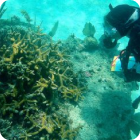
By: Kyle Grammatica
A team of Florida Fish and Wildlife Conservation Commission (FWC) researchers have been investigating the reef communities found on hard-bottom ledges in the Gulf of Mexico thanks to a grant from the Foundation. These ledges were once the ancient limestone shorelines of Florida. Now, they are vertical drop-offs along the ocean floor that provide cover and habitat for marine animals. Unlike reefs in the Florida Keys, ledge reefs are not built by corals. Instead, the structure of the ledge forms the backbone of the reef community. With the Foundation’s support, biologists have been able to learn more about these unique structures and the animals that call them home.
For the project, researchers visited 15 offshore ledges from Sarasota to Clearwater and conducted surveys of the fish and invertebrates living in and around the area. These surveys allow researchers to track both short-term changes in aquatic communities from things like red tide, as well as long-term health and population trends.
This region of the Gulf of Mexico was chosen because it is a biogeographic transition zone between subtropical and temperate climates. Surveying in this zone can help researchers understand how much climate change is affecting the distribution of marine animals. If our waters are warming, tropical fish and invertebrates may expand their range northward into the transition zone, which seems to be happening based on the team’s results. For instance, researchers noticed species that are more commonly found in the tropical Caribbean. While it is somewhat common for a few tropical fish species to appear in this region, usually it is only the juveniles. However, researchers are now seeing adults of these species at the ledge reefs, suggesting that they are surviving winter and may be permanent residents of the ledge communities. They also documented the presence of anemone species that have not yet been observed this far north. In the Caribbean, these anemones host shrimp and act as “cleaning stations” that fish visit to have parasites removed. This summer researchers will use drop cameras to find out if fish visit them to get cleaned like in the tropics.
To fund research and conservation projects like this one, purchase our Conserve Wildlife plate online here!











